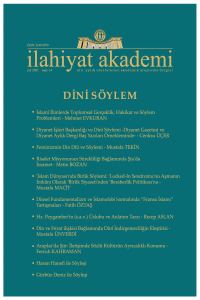Püritanizm ve Dinî/Ahlâki Yozlaşma: Nathaniel Hawthorne’un Kızıl Damga’sı / Puritanism and Religious/Moral Corruption: The Scarlet Letter by Nathaniel Hawthorne/ المذهب التطهيري البيوريتاني والفساد الديني/الأخلاقي: الحرف القرمزي لناثانيال هاوثورن
Teolojik kaynağını Kalvinizm’den alan Püritanizm, Amerika Birleşik Devletleri’ni bugünkü dinî, kültürel, siyasî, ekonomik ve toplumsal panoramasının değerlendirilmesinde önemli bir yer tutar. 1620’de Amerika’ya ilk gelen Püritanlar Plymouth, Massachusetts’de bir koloni kurmuşlar, 1630’lu yıllarda ikinci bir göçmen dalgası başlamıştır. Bu grup günümüzde Boston olarak bilinen bölgede Massachusetts Bay Colony adını verdikleri bir cemaat kurmuşlardır. Kendi dışındaki din ve dünya görüşlerine müsamaha göstermeyen bu Püritan cemaat, Nathaniel Hawthorne’un Kızıl Damga’sının tam da merkezini oluşturur. Amerikan Rönesansı olarak bilinen dönemde bir ahlâkçı olarak özgün eserler veren Nathaniel Hawthorne, dedelerinin koloni yıllarında Püritan olmayanlara karşı yargıç olarak gerçekleştirdikleri zulüm ve adil olmayan suçlamalar ve infazlardan dolayı her zaman sıkıntı duymuş, kendisini suçluluk duygusundan kurtaramamıştır. Belki de bu yüzden Kızıl Damga adlı eserinde kasvetli Püritan dünyasını aslına uygun biçimde yeniden üretirken, Püritan tarihine karşı ahlâk yasasını betimlemeye ve Püritan inancının bozulmuş yönlerini gözler önüne sermeye çalışmıştır. Bu çalışmada Nathaniel Hawthorne’un yaşamıyla yazdığı eser arasındaki ilişki, Püritan Amerika eleştirisi ve dinî/ahlâki yozlaşma, başeseri Kızıl Damga üzerinden ele alınacaktır.
Anahtar Kelimeler:
Nathaniel Hawthorne, Kızıl Damga, Püritanizm, dinî/ahlâki yozlaşma
Puritanism and Religious/Moral Corruption: The Scarlet Letter by Nathaniel Hawthorne
Puritanism, theologically rooted in Calvinism, has an important place to evaluate the current religious, cultural, political, economic, and social panorama of the U.S. The first Puritans who came to America in 1620 settled in Plymouth, Massachusetts, in the 1630s a second immigration wave began. This group established a community called Massachusetts Bay Colony in an area known today as Boston. This Puritan community which did not tolerate any dissenting religious or world views is the very center of The Scarlet Letter by Nathaniel Hawthorne. Hawthorne who produced original works as a moralist in the period known as the American Renaissance was distressed and had a guilty conscience because of cruelty and unfair accusations and executions by his great great father and great father as judges at that time. Perhaps due to this fact, he tried to describe the moral law against the Puritan history and to show the corrupted aspects of Puritan faith while reproducing the gloomy Puritan world literally in his works. In this study the relationship between the life of Hawthorne and his work, his criticism of Puritan America, and religious/moral corruption are treated through his masterpiece, The Scarlet Letter.
___
- Bell, Millicent, Hawthorne and the Real: Bicentennial Essays, Ohio State University Press, Columbus 2005.
- 2. Elliott, Emory, “The Legacy of Puritanism, Divining America”, TeacherServe©, National Humanities Center, http://nationalhumanitiescenter.org/tserve/eighteen/ekeyinfo/legacy.htm, (10.01.2016)
- Fujie, Keiko “Hawthorne's Light & Dark in The Scarlet Letter”, Osaka Literary Review, 1980-11-30, s. 116-127.
- Glazier, Lyle, Decadence and Rebirth, Hacettepe Lectures in American Literature, Hacettepe University Publications, Ankara 1971.
- Graham, Wendy C., Gothic Elements and Religion in Nathaniel Hawthorne's Fiction, Tectum Verlag DE, Marburg 1999.
- Güriz, Adnan, “Avrupada Reform Hareketi ve Mülkiyet Sorunu”, http://dergiler.ankara.edu.tr/dergiler/38/335/3397.pdf 256-257, (05.01.2016).
- Hall, Kevin, Calvinism, Introduction to the Study of Calvinism, http://www.biblestudyguide.org/ebooks/kevinhall/calvinism-te.pdf, (07.01.2016).
- Hawthorne, Nathaniel, Kızıl Damga, çev. Z. Gülümser Ağırer Çuhadar, Arıon Yayınevi, İstanbul 2002.
- Hawthorne, Nathaniel, The House of the Seven Gables, Airmont, New York 1963.
- Horton, Michael, For Calvinism, Zondervan, Michigan 2011.
- Imene, Kahhoul, Puritanical Dimensions in The Scarlet Letter: Moral Demands Versus Individual Needs, Mohamed Khider University – Biskra Faculty Of Letters and Languages Department of Foreign Languages, English Branch, Algeria 2011/2012.
- Kilbourne, Benjamin “Shame Conflıcts and Tragedy in The Scarlet Letter”, Japa, 53/2, s. 465-483.
- Ladenburg, Thomas, “Amerika’s Manifest Destiny”, Digital History, s. 40-41 http://www.digitalhistory.uh.edu/teachers/lesson_plans/pdfs/unit5_8.pdf, (15.01.2016).
- Lemay, J. A. Leo, An Early American Reader, United States Information Agency, Washington DC. 1993.
- Levin, David, “Nathaniel Hawthorne, The Scarlet Letter”, The Voice of America, Forum Lectures, The American Novel, United States Information Agency, Washington DC. 1977, s. 10-17.
- Levin, Harry, The Power of Blackness, Vintage Books, New York, 1958.
- Madsen, Deborah L., “Hawthorne’s Puritans. From Fact to Fiction”, Journal of American Studies 33.3 1999, s. 509-517.
- Meltzer, Milton, Nathaniel Hawthorne: A Biography, Twenty-First Century Books, Minneapolis 2007.
- Old, Hughes Oliphant, Worship: Reform According to Scripture, Westminster John Knox Press, Louisville 2002.
- Ousby, Ian, An Introduction to Fifty American Novels, Pan Books, London 1979.
- Pfister, Joel, “Hawthorne as Cultural Theorist”, The Cambridge Companion to Nathaniel Hawthorne, Cambridge University Press, Cambridge 2004, s. 35-59.
- Ruland, Richard; Bradbury, Malcolm, From Puritanism to Postmodernism: a History of American Literature, Penguin Books, New York, 1991.
- Torun, İshak, “Kapitalizmin Zorunlu Şartı ‘Protestan Ahlâk’ ”, C.Ü. İktisadi ve İdari Bilimler Dergisi, 2002, III/2, 89-98.
- http://college.cengage.com/english/lauter/heath/4e/students/author_pages/early_nineteenth/hawthorne_na.html, (06.01.2016).
- http://home.arcor.de/vhailor/413_FF_Fact_file_3_NRW.pdf, s. 1, (14.01.2016).
- ISSN: 2149-3979
- Yayın Aralığı: Yılda 2 Sayı
- Başlangıç: 2015
- Yayıncı: Gaziantep Üniversitesi
